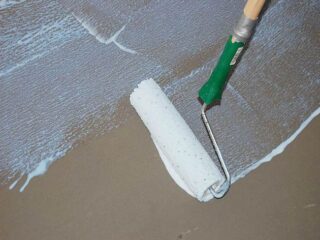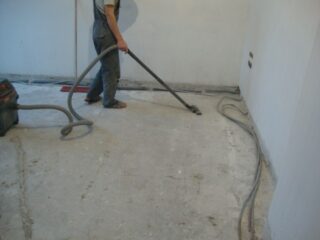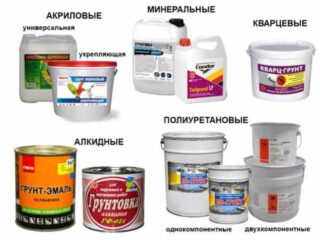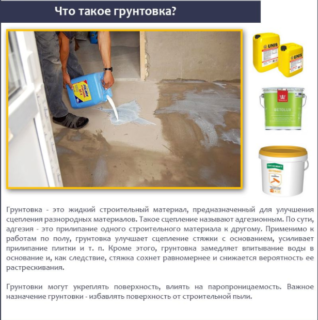A screed made with a self-leveling mixture is called a self-leveling floor. Distinguish between finishing and roughing layers, which differ in functionality. Before starting the installation, make preparations using a primer for self-leveling floor. The technology differs from cement-sand screed and concreting in low labor intensity and high efficiency.
The need to use a primer for self-leveling floor

Self-leveling floors are produced on the basis of epoxy polymers, polyurethane, cement and gypsum. The composition is stirred at the site of application and poured onto the floor.
The surface is leveled by the spreading of the mixture under the influence of gravity. The types of composition are chosen depending on the humidity of the room microclimate and the thickness of the required screed.
Treatment with an impregnating agent strengthens the base, binds dust particles, improves the adhesion of the pouring compound to the surface. Due to this, water from the composition does not go into the overlap material, the hardening of the mixture occurs in a technological mode. The primer for the floor under the self-leveling floor is applied on dense or loose substrates.
Dry and liquid primers
Deep penetration compositions are distinguished by their characteristics:
- appearance in the initial state (dry mixture or liquid solutions);
- purpose of application;
- type of surface to be treated.
To protect against moisture, mixtures with hydrophobic properties are used. They are produced with the addition of acrylic copolymers and antifungal agents. At the same time, they strengthen the surface.
Dry
Such formulations are produced in powder form, which is mixed with water in place before use. According to their intended purpose, soils are produced for indoor and outdoor use.
When buying a composition, take into account that soils are used for processing metal, brick, wood, drywall and other surfaces. When diluting, you need to accurately measure the amount of powder to obtain the desired concentration.
Liquid
The advantage is that the solutions are made in the factory, so the components are injected in precise proportions, and the liquid is ready for use. They do not require dilution other than mixing.
After application, a solid surface is obtained, on which the self-leveling layer is poured. Impregnations are sold in small plastic bottles or buckets.
Compositions of primers for self-leveling floors
There are a large number of specialized soils:
- glyphthalic - for metal in dry rooms;
- perchlorovinyl - for covering stone, metal;
- polyvinyl acetate - only for the corresponding paint.
There are phenolic and polystyrene varieties for outdoor use.
Alkyd
It works well on wood substrates, but is also suitable for fiberglass, ceramic floor tiles, metal, plastic. Such mixtures do not change the quality in case of temperature drops, withstands the range from -40 to + 60 ° С.
Limitations of use relate to plaster surfaces, and this also includes loose and flaking substrates. The alkyd primer dries for almost a day.
Mineral
They are used for covering from concrete, expanded clay concrete, screed, aerated concrete.The composition is based on lime, cement, gypsum. Drying time varies from 2 to 24 hours and depends on the selected brand.
Oils, adhesives, bitumen, resins are introduced into the composition, hardening accelerators are used. Modifiers are used in the form of insecticides, water-repellent components, adsorbent additives.
Acrylic
The composition contains chalk, graphite, copper sulfate, these substances are combined on a basis of acrylic and latex. The composition is dissolved with water, so the layer dries quickly. Organic solvent-based primers are used inside and outside the building.
The peculiarity is that there are no pungent odors during processing. Consumption depends on the porosity of the surface; a larger volume of the product is used for loose areas.
Classification of primers by properties
- universal action;
- fixing the surface;
- adhesive to increase adhesion;
- multifunctional.
There are also varieties of primer under the self-leveling floor for deep penetration into the base layer, increasing the resistance of the floor against fire. For metal surfaces, anti-corrosion primers are used.
Universal
They are dispersive suspensions based on solvents, water, and solvents. Can be used on any surface. Impregnations can be primed in cold climates, they are used when laying self-leveling floors in the open air. They are convenient to use because they are sold in a ready-to-use form.
Strengthening
More often, such compositions are referred to as deep penetration tools. At the same time, such compositions, after drying, protect the surface from water, while the vapor permeability remains. Liquid solutions penetrate up to 1 - 5 cm in depth.
For loose substrates, impregnations are sold, which indicate that they are intended for weakened surfaces.
Adhesive
Increase adhesion of the subsequent layer to the treated area of the coating. The composition includes polymer suspensions based on urethane or acrylic resin, dyes, modifiers. The mineral aggregate is often introduced in the form of fine quartz sand. The surface is roughened by the last component and adhesion is increased.
Multifunctional
Preparatory impregnations of this type are used on wooden coatings, on a sheet layer of chipboard, plywood. Compositions adhere to asphalt, stone, and ceramics substrates. Preparatory primers are used on floors where, after dismantling the old coating, layers of bitumen and resin remain. You can prime areas where there are uncleaned residues of mortar, glue.
When buying, take into account the type of floor material and the type of room. If alkali, anti-fire additives were added to the screed mixture, impregnations with anti-alkaline characteristics should be chosen. Sometimes the floor area does not need to be leveled, the composition will be poured immediately. In this case, a primer is purchased for finishing.
DIY priming procedure

The area of the future laying of the self-leveling floor is cleaned of dust. Knock down weak layers in the form of a peeled solution, tile glue. I remove the cover from linoleum, laminate, parquet and other finishes.
Make repairs to the base. To do this, the cracks are sewn up and they are sealed with a mortar of sand and cement for stone and concrete slabs. The wood is putty with appropriate mixtures.
The primers are applied to the surface with the help of bristle brushes, rollers with foam, fur or thread nozzles are used. For large surfaces, spray guns are used. Surface cleaning is carried out using scrapers, spatulas, a perforator or a bump stop is used.
As a material, impregnations are taken that are suitable in quality for a specific situation.
Work begins on the far side of the floor, away from the entrance. The composition is applied in areas that can be processed, getting from one parking lot.The movements of the brush or roller are directed first in one direction, then in the other direction, so that the composition fills all the grooves on the surface.
They wait for drying for as long as indicated on the packaging for various types of impregnations.










